Special Feature: Products Sally Recommends
Discovering Brontë Country in a Volvo XC90
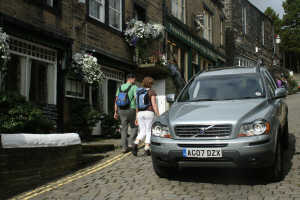 It was time to ferry our daughter Chloe back to university in Manchester after the summer vacation and luckily we had the perfect vehicle to get her mountains of luggage loaded and delivered to her new apartment. The Volvo XC90 is a surprisingly big car and yet, when you drive it, there is no feeling of it being bulky, even on small country roads. It has a seven-seat cabin and is very versatile. With good space in the front two rows, the rear seats are for children. And the rearmost seats fold under the floor when not in use to create a massive loading area. The three middle seats also slide individually and are easy to fold flat. It gives a very smooth ride and its four-wheel drive system cleverly sends most of the power to the front wheels and then full four wheel drive kicks in when it is needed. We also like the split tailgate, a feature that comes on very few of these big four wheel drives. It makes a huge difference when it comes to loading and, besides, the lower section is perfect as a table or for sitting on.
It was time to ferry our daughter Chloe back to university in Manchester after the summer vacation and luckily we had the perfect vehicle to get her mountains of luggage loaded and delivered to her new apartment. The Volvo XC90 is a surprisingly big car and yet, when you drive it, there is no feeling of it being bulky, even on small country roads. It has a seven-seat cabin and is very versatile. With good space in the front two rows, the rear seats are for children. And the rearmost seats fold under the floor when not in use to create a massive loading area. The three middle seats also slide individually and are easy to fold flat. It gives a very smooth ride and its four-wheel drive system cleverly sends most of the power to the front wheels and then full four wheel drive kicks in when it is needed. We also like the split tailgate, a feature that comes on very few of these big four wheel drives. It makes a huge difference when it comes to loading and, besides, the lower section is perfect as a table or for sitting on.
There are powerful 3.2 six-cylinder and 4.4-litre V8 petrol engines to choose from with a six speed auto box. In Britain most people opt for the more economical D5 turbo diesel and that comes with the optional five-speed automatic gearbox, but it works perfectly well and adds quite a lot to the fun of driving the car. Driving south from our home the car was very comfortable. There was no wind noise and we like that very comforting feeling of being well up from the road.
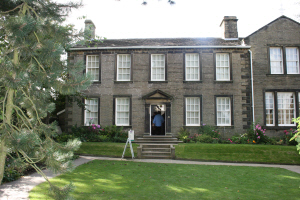 Chloe’s university isn’t far from Haworth Parsonage, home and now shrine to the three Brontë sisters – Charlotte, Emily and Anne and it hasn’t changed much in two centuries. The stone flagged floors, the furniture, the long case clock half way up the staircase that Mr. Brontë religiously wound every night on his way to bed are telling reminders of how this remarkable family lived. And, just as Charlotte’s biographer Elizabeth Gaskell discovered when she visited the Brontës in 1853, everything shines like a new pin. So struck was she by the immaculate condition of the house that she wrote to a friend saying: “Everything fits into, and is in harmony with, the idea of a country parsonage, possessed by people of very moderate means. Everything about the place tells of the most dainty order, the most exquisite cleanliness. The doorsteps are spotless; the small old-fashioned windowpanes glitter like looking glass. Inside and outside of that house cleanliness goes up into its essence, purity.”
Chloe’s university isn’t far from Haworth Parsonage, home and now shrine to the three Brontë sisters – Charlotte, Emily and Anne and it hasn’t changed much in two centuries. The stone flagged floors, the furniture, the long case clock half way up the staircase that Mr. Brontë religiously wound every night on his way to bed are telling reminders of how this remarkable family lived. And, just as Charlotte’s biographer Elizabeth Gaskell discovered when she visited the Brontës in 1853, everything shines like a new pin. So struck was she by the immaculate condition of the house that she wrote to a friend saying: “Everything fits into, and is in harmony with, the idea of a country parsonage, possessed by people of very moderate means. Everything about the place tells of the most dainty order, the most exquisite cleanliness. The doorsteps are spotless; the small old-fashioned windowpanes glitter like looking glass. Inside and outside of that house cleanliness goes up into its essence, purity.”
By this time, however, tragedy had struck the Brontës in plenty. Charlotte was the only one left alive of the six children born to Maria and Patrick Brontë, who had taken his young family to Haworth when he was appointed curate there in 1820.
A year and a half after moving in his wife died of cancer. Luckily for the family Aunt Elizabeth Branwell was prepared to leave the cosy climes of Cornwall to take over the reins of her dead sister. Less than four years later his first born Maria, aged only eleven, died after taking ill at school, quickly followed after a few months by ten year old Elizabeth in 1825.
During this difficult time Aunt Elizabeth had taken on the role of matriarch but she also contributed substantially to the household expenses from her own money until she died in 1842. The remaining Brontë sisters were left an inheritance by their aunt, which enabled them to publish Poems, Wuthering Heights and Agnes Grey. But more deaths came thick and fast. Branwell, the only son, a talented painter and budding writer too, died at thirty one in 1848 having taken to drink and opium, followed by Emily, aged thirty that same year from consumption. And only five months later Anne succumbed to tuberculosis and died in Scarborough where she had gone for the sea air in the hope of a cure.
It was not unusual to die young at this time. And while life in Haworth, high in the Yorkshire moors, with a surprisingly good diet of game, beef, mutton, fresh bread and oatmeal not to mention long bracing walks in the fresh air, might have seemed the perfect antidote to catching some life-threatening disease it was in fact no protection. (Although it must have done something for Patrick Brontë because he lived to the ripe old age of eighty four). Once again Mrs. Gaskell gives us a clue to the harsh conditions that the Brontës endured in the winter. “On autumnal or winter nights the four winds of heaven seemed to meet and rage together tearing round the house as if they were wild beasts trying to find an entrance.”
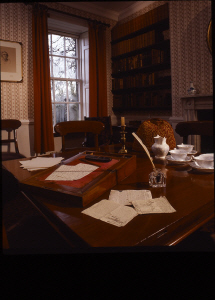 Open fires lit very early in the morning helped to make life bearable but the stone floors were damp. Today the house ducks behind the shelter of mature sycamore and pine trees. When the Brontës were in residence there would have been little or no shelter for the house.
Open fires lit very early in the morning helped to make life bearable but the stone floors were damp. Today the house ducks behind the shelter of mature sycamore and pine trees. When the Brontës were in residence there would have been little or no shelter for the house.
Driving up the main street of Haworth, which climbs steeply to the church and parsonage, the tyres of the big Volvo gripped the large stone sets that were laid like cobbles in the road. This had a great advantage for the horses and carts that once struggled up this steep hill. They could get a grip on the stone and were not likely to slip or stumble. The Volvo, with its four wheel drive, needed no such assistance of course.
We had booked in for the night at The Coffee House, number 10 to be exact, which sits towards the bottom of the main street. It came highly recommended from the museum’s librarian Anne Dinsdale, whose latest book, The Brontës of Haworth, is a most informative and attractive book full of excellent pictures. She told us that not only could we enjoy amazing coffee and a rich array of freshly baked cakes but we could also stay in one of the rooms and enjoy a most delicious breakfast the next morning.
It sounded too good to be true but from the moment you arrive Claire Smith, who owns and runs it, throws a warm blanket of welcome around everything she touches. “When I set up my coffee house the whole idea was to make it a very special treat making cakes such as French chocolate cake, lemon, ginger and fruit cakes.” She also makes mouth-watering pastries, fruit tarts, strawberry cheese cakes, and Victoria sponges. On a typical day she starts baking at seven in the morning and will make between twelve and fifteen cakes, not to mention a range of scones.
As a result she gets queues forming outside the door. “People ring me up in the morning to reserve their cakes and they say, ‘make sure you keep us a piece of apple and cinnamon or lemon cake’, which of course I do.” Claire was greatly influenced by her mother and grandmother. They too were cake makers. But Claire is one of those cooks who never weigh out the ingredients. She seems to instinctively know when something is right. She likes to experiment and create new kinds of cakes.
And as she cooks she likes to play music. “I call it my fairy music, soft and magical.” But she has been known to play rock or Spanish guitar music. That’s when she can be heard breaking into song herself!
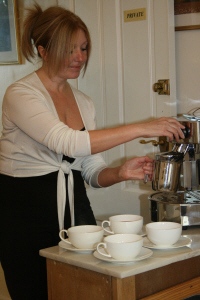 “I’m rather whacky about my cakes. To me they’re like little people,” Claire told us with a smile. “When I’m making them I think about them all the time. My cakes speak to me and they tell me when they want to come out of the oven. I can just feel them being ready!”
“I’m rather whacky about my cakes. To me they’re like little people,” Claire told us with a smile. “When I’m making them I think about them all the time. My cakes speak to me and they tell me when they want to come out of the oven. I can just feel them being ready!”
When you order coffee in Claire’s shop she likes you to have good sniff of the beans beforehand. If they are not to your liking she’ll bring another variety as you discuss the various strengths and origins of the coffee. “I just want my customers to feel good and cared for.”
Our room was very pleasant looking out on the historic main street and the next morning we set off after a hearty and beautifully cooked breakfast of scrambled eggs, bacon and sausages with lashings of Claire’s wonderful coffee. Oh, and we do believe there was a piece of cake somewhere on our plates!
A short drive out of Haworth is Ponden House, owned and run by Brenda Taylor. It sits close to Ponden Hall which may have been the model for Thrushcross Grange the home of the Lintons in Wuthering Heights. Sitting, as we were, high up in the cabin of the Volvo gave us wonderful views of the surrounding moors. The XC90 is Volvo’s first 4x4 and it was awarded a maximum five stars in Euro NCAP’s crash test thanks to twin front and side airbags, cabin-length window airbags, a strengthened roof and anti-whiplash front head restraints. Anti-lock brakes and stability control go a long way to preventing crashes, and an excellent security kit makes the XC90 as theft-resistant as other Volvos. The seats are also very comfortable and the driver’s seat features an excellent range of adjustment, while a two-way adjustable steering column makes it easy to find the right position for every type of driver.
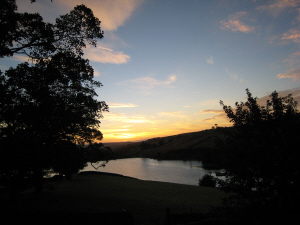 Ponden House has spectacular views overlooking a lake and the walking is sublime. We stayed one night with Brenda in her lovely welcoming house. Built of old stone it merges into the countryside from where much of the ingredients for her cooking originates. The lamb, beef and game is superb and we tucked into a lovely beef casserole with fresh vegetables and potatoes and a fruit pudding with cream.
Ponden House has spectacular views overlooking a lake and the walking is sublime. We stayed one night with Brenda in her lovely welcoming house. Built of old stone it merges into the countryside from where much of the ingredients for her cooking originates. The lamb, beef and game is superb and we tucked into a lovely beef casserole with fresh vegetables and potatoes and a fruit pudding with cream.
One of her guests was a young doctor from Holland who had come on a walking holiday. He had fallen for this part of Yorkshire in a big way and thought it was the best walking he had ever experienced. Breakfast was nicely done with a range of cereals and plenty of eggs and bacon and afterwards, on a perfect sunny morning, we set off on a short walk of our own just above the house. We looked at the old Ponden Hall and the date plaque above the door which told us that it was rebuilt in 1801, the same date that the story of Wuthering Heights begins.
Before leaving for home we drove up the famous main street of Haworth for a final time. From a car that would have seemed like a space ship to the Brontës with its climate control, cruise control and alloy wheels, leather upholstery, a CD multichanger, sat-nav and a refrigerator, we reflected just how hard life would have been then. There were no sewers and no drains in the street. It ran with every kind of waste and effluent that the local villagers needed to get rid of. And the lower you were in the steep street that ran from the parsonage and the church the worse off you would be. Disease was rife.
The gravestones in the churchyard tell their own story. Nearly half the children who were born in Haworth were buried before they reached the age of six. Many causes of death were listed as ‘unknown’ but common causes were tuberculosis, scarlet fever, rheumatic fever, croup, measles, and childbirth. There were also many industrial accidents in the mills and quarries around Haworth where men women and children worked.
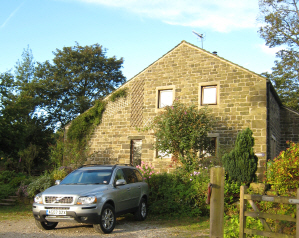 As we toured the parsonage with Anne Dinsdale she gave us a wonderful insight into the way of life there. It was home to the Brontës for over forty years. One room, the dining room or parlour, has a particular fascination. It is where Charlotte, Emily and Anne did most of their writing. Jane Eyre, Wuthering Heights, Agnes Grey, and The Tenant of Wildfell Hall – they all came from this room. And one of their remarkable routines, perhaps done to gain inspiration, was to walk round and round the dining room table reading and discussing their writings and the plans they had. This could go on late into the night. After both Emily and Anne had died Charlotte continued to pace around the table on her own, unable to go to sleep until she had carried out this nightly ritual.
As we toured the parsonage with Anne Dinsdale she gave us a wonderful insight into the way of life there. It was home to the Brontës for over forty years. One room, the dining room or parlour, has a particular fascination. It is where Charlotte, Emily and Anne did most of their writing. Jane Eyre, Wuthering Heights, Agnes Grey, and The Tenant of Wildfell Hall – they all came from this room. And one of their remarkable routines, perhaps done to gain inspiration, was to walk round and round the dining room table reading and discussing their writings and the plans they had. This could go on late into the night. After both Emily and Anne had died Charlotte continued to pace around the table on her own, unable to go to sleep until she had carried out this nightly ritual.
There is also a black horse hair sofa made by the local carpenter in Haworth (he also made the original dining table and other furniture in the house). It is on this sofa that Emily is thought to have died, having refused to see a doctor until it was too late.
In 1927 the parsonage was bought for £3,000 from the Church by Sir James Roberts, a local man who had made a great deal of money in the textile industry. He donated the house to the Brontë Society, formed in 1893, which had always hoped to get hold of the house but with only fifty pounds in the bank could never have afforded it! Sir James gave them another £1500 towards the cost of setting up the museum and in the autumn of 1928 thousands of people flocked to Haworth for the official opening.
Once the parsonage became a museum, all sorts of Brontë pieces, which had been sold off over the years, were returned and donated, including furniture and the superb collection of manuscripts, drawings and books which were sent to the museum as a bequest from the collection of Henry Houston Bonnell in America.
Thanks to the hard work and foresight of the Brontë Society the long climb up the main street of Haworth to visit the Brontë Parsonage is an unforgettable experience. Once there you glimpse what seems to us now a simple but contented way of life. But when you remember that this house produced the most famous literary family in the world and that more than 150 years later their novels continue to fascinate and intrigue millions of readers it makes it all the more remarkable. Our advice is simple. Go there if you possibly can and soak it all up.
GETTING THERE
Keith and Lynne travelled from their home in Berwick upon Tweed in a Volvo XC90
For more details on this model and the full range of Volvo vehicles: www.volvocars.com
WHERE TO STAY
The Coffee House
10 Main Street Haworth
+44 (0) 1535 644694
Ponden House
Stanbury
Nr Haworth
Keighley
W Yorks
BD22 0HR
+44 (0) 1535 644154
www.pondenhouse.co.uk
RECOMMENDED READING
Not surprisingly, there is a very good range of Brontë books to be had in the museum shop. We settled on Anne Dinsdale’s book, The Brontës of Haworth, with splendid photographs by Simon Warner and published by Frances Lincoln Limited and a number of books published by Oxford University Press including The Tenant of Wildfell Hall and Jane Eyre. We also picked up The Oxford Companion to the Brontës by Christine Alexander and Margaret Smith, and Last Things, Emily Brontës Poems by Janet Gezari, both published by Oxford University Press. www.oup.com
![]()
Husband and wife, Keith Allan and Lynne Gray are travel writers and photographers based in Berwick upon Tweed on the English/Scottish border. They have worked for The Times, Daily Telegraph, Financial Times, House and Garden, Scotland on Sunday and The Herald. For more than twenty years they have worked as freelance producers and reporters for BBC Radio, working from their own independent studio for BBC Radio 4, Radio 5 and Radio Scotland as well as the BBC’s World Service.
Note: This information was accurate when it was published. Please be sure to confirm all rates and details directly with the businesses in question before making your plans.



